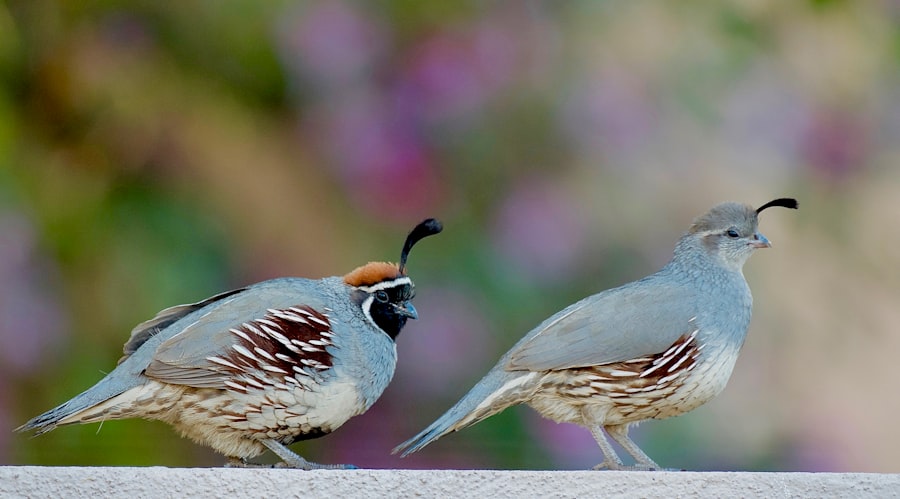Ulcerative enteritis is a highly contagious bacterial disease that affects quail, particularly those raised in commercial production settings. The disease is caused by the bacterium Clostridium colinum, which can lead to severe intestinal inflammation and ulceration in affected birds. Quail infected with ulcerative enteritis may exhibit symptoms such as decreased feed intake, weight loss, diarrhea, and sudden death. The disease can spread rapidly within a flock, leading to significant economic losses for quail producers.
In order to effectively manage and prevent ulcerative enteritis in quail, it is crucial for producers to have a thorough understanding of the disease and its transmission. The bacterium responsible for ulcerative enteritis can survive for extended periods in the environment, particularly in warm and humid conditions. Additionally, the disease can be transmitted through contaminated feed, water, and equipment, as well as through direct contact with infected birds. Understanding the routes of transmission and the environmental factors that contribute to the spread of ulcerative enteritis is essential for implementing effective biosecurity measures and minimizing the risk of disease outbreaks.
Ulcerative enteritis can have a significant impact on quail health and production, making it essential for producers to be well-informed about the disease and its management. By understanding the causes, symptoms, and transmission of ulcerative enteritis, quail producers can take proactive measures to protect their flocks and minimize the risk of disease outbreaks.
Table of Contents
- 1 Selecting Quail Breeding Stock for Resistance
- 2 Implementing Biosecurity Measures to Prevent Ulcerative Enteritis
- 3 Utilizing Genetic Selection for Resistance
- 4 Monitoring and Managing Quail Health
- 5 Collaborating with Veterinarians and Researchers
- 6 Promoting Sustainable and Resilient Quail Production
- 7 FAQs
- 7.1 What is ulcerative enteritis in quail?
- 7.2 How can quail be bred for resistance to ulcerative enteritis?
- 7.3 What are the benefits of breeding quail for resistance to ulcerative enteritis?
- 7.4 Are there any challenges associated with breeding quail for resistance to ulcerative enteritis?
- 7.5 Can breeding for resistance to ulcerative enteritis be combined with other breeding goals?
Key Takeaways
- Ulcerative enteritis is a common and potentially devastating disease in quail, caused by the bacterium Clostridium colinum.
- Select breeding stock for resistance to ulcerative enteritis by choosing birds with a history of good health and strong immune systems.
- Implement biosecurity measures such as strict sanitation, controlled access, and quarantine to prevent the spread of ulcerative enteritis on quail farms.
- Utilize genetic selection for resistance by breeding quail with known resistance to ulcerative enteritis, and avoiding inbreeding.
- Monitor and manage quail health by regularly inspecting birds for signs of illness, providing a balanced diet, and promptly treating any suspected cases of ulcerative enteritis.
- Collaborate with veterinarians and researchers to stay updated on the latest developments in ulcerative enteritis prevention and treatment.
- Promote sustainable and resilient quail production by following best practices for disease prevention and maintaining a healthy quail population.
Selecting Quail Breeding Stock for Resistance
Selecting quail breeding stock with resistance to ulcerative enteritis is a critical component of disease management and prevention. By choosing birds that demonstrate natural resistance to the bacterium responsible for ulcerative enteritis, producers can reduce the likelihood of disease outbreaks and minimize the impact of the disease on their flocks. When selecting breeding stock, producers should consider factors such as genetic diversity, overall health and vigor, and resistance to common diseases, including ulcerative enteritis.
One approach to selecting resistant breeding stock is to work with reputable quail breeders who prioritize disease resistance in their breeding programs. These breeders may utilize selective breeding techniques to identify and propagate birds with natural resistance to ulcerative enteritis, ultimately producing offspring with enhanced disease resistance. Additionally, producers can implement regular health screenings and testing to identify birds that demonstrate resistance to ulcerative enteritis and other common diseases. By incorporating disease resistance as a key selection criterion, producers can gradually improve the overall health and resilience of their quail flocks.
Selecting quail breeding stock for resistance to ulcerative enteritis requires careful consideration of genetic factors, health status, and disease resistance. By working with reputable breeders and implementing rigorous selection criteria, producers can gradually enhance the disease resistance of their quail flocks and reduce the impact of ulcerative enteritis on their production operations.
Implementing Biosecurity Measures to Prevent Ulcerative Enteritis
Implementing robust biosecurity measures is essential for preventing the introduction and spread of ulcerative enteritis in quail flocks. Biosecurity encompasses a range of practices and protocols designed to minimize the risk of disease transmission within and between flocks. Key biosecurity measures for preventing ulcerative enteritis include controlling access to production facilities, implementing strict sanitation protocols, and monitoring the health status of incoming birds.
Controlling access to production facilities is a fundamental biosecurity measure that can help prevent the introduction of ulcerative enteritis and other infectious diseases. Producers should limit access to their facilities to essential personnel only, while also implementing visitor protocols and vehicle disinfection procedures. Additionally, strict sanitation protocols should be established to minimize the risk of disease transmission within the facility. This may include regular cleaning and disinfection of equipment, as well as the implementation of foot baths and hand hygiene stations at key entry points.
Monitoring the health status of incoming birds is another critical biosecurity measure for preventing ulcerative enteritis. Producers should work with reputable suppliers and conduct thorough health screenings prior to introducing new birds into their flocks. By implementing these biosecurity measures, producers can reduce the risk of ulcerative enteritis outbreaks and protect the health and productivity of their quail flocks.
Utilizing Genetic Selection for Resistance
Genetic selection for resistance to ulcerative enteritis is a powerful tool for enhancing the disease resistance of quail flocks. By identifying and propagating birds with natural resistance to the bacterium responsible for ulcerative enteritis, producers can gradually improve the overall health and resilience of their flocks. Genetic selection involves identifying birds with desirable traits, such as disease resistance, and using them as breeding stock to produce offspring with enhanced resistance.
One approach to utilizing genetic selection for resistance is to conduct regular health screenings and testing to identify birds that demonstrate natural resistance to ulcerative enteritis. By incorporating disease resistance as a key selection criterion, producers can gradually enhance the overall health and resilience of their quail flocks. Additionally, working with reputable quail breeders who prioritize disease resistance in their breeding programs can provide access to birds with enhanced genetic resistance to ulcerative enteritis.
Genetic selection for resistance to ulcerative enteritis requires a long-term commitment to identifying and propagating birds with desirable traits. By incorporating disease resistance as a key selection criterion and working with reputable breeders, producers can gradually enhance the overall health and resilience of their quail flocks.
Monitoring and Managing Quail Health
Monitoring and managing quail health is essential for preventing and controlling diseases such as ulcerative enteritis. Regular health screenings, observation of flock behavior, and proactive management practices are critical components of maintaining a healthy quail flock. By closely monitoring the health status of their birds and implementing effective management strategies, producers can minimize the risk of disease outbreaks and promote overall flock resilience.
Regular health screenings are an important tool for monitoring quail health and detecting potential issues such as ulcerative enteritis. Producers should work with veterinarians to establish routine health monitoring protocols, including regular physical examinations, fecal testing, and blood screenings. These screenings can help identify early signs of disease or underlying health issues, allowing producers to take proactive measures to address potential concerns.
In addition to regular health screenings, observation of flock behavior can provide valuable insights into the overall health and well-being of quail. Producers should closely monitor flock behavior, feed consumption, and egg production patterns to identify any changes that may indicate underlying health issues. By staying vigilant and proactive in monitoring flock behavior, producers can quickly identify potential health concerns and take appropriate action to address them.
Proactive management practices are essential for maintaining quail health and minimizing the risk of diseases such as ulcerative enteritis. This may include implementing effective biosecurity measures, providing a balanced diet, maintaining optimal environmental conditions, and promptly addressing any signs of illness or distress. By taking a proactive approach to managing quail health, producers can promote overall flock resilience and minimize the impact of diseases such as ulcerative enteritis.
Collaborating with Veterinarians and Researchers

Collaborating with veterinarians and researchers is essential for gaining valuable insights into disease management strategies and enhancing the overall health and resilience of quail flocks. Veterinarians play a critical role in providing expert guidance on disease prevention, diagnosis, and treatment, while researchers contribute valuable knowledge through ongoing studies and research initiatives. By working closely with these professionals, producers can access specialized expertise and stay informed about the latest developments in quail health management.
Veterinarians can provide valuable support in developing comprehensive health management plans for quail flocks, including disease prevention strategies, vaccination protocols, and treatment options. Producers should establish a collaborative relationship with a qualified avian veterinarian who has experience working with quail species. By consulting with veterinarians on a regular basis, producers can gain valuable insights into maintaining optimal flock health and addressing potential health concerns.
Researchers also play a crucial role in advancing our understanding of quail health management and disease prevention strategies. By staying informed about ongoing research initiatives and participating in collaborative research projects, producers can contribute to the development of innovative disease management approaches and gain access to cutting-edge knowledge in the field of avian health. Collaborating with researchers can provide producers with valuable insights into emerging diseases, novel treatment options, and best practices for promoting overall flock resilience.
By collaborating with veterinarians and researchers, producers can gain access to specialized expertise and stay informed about the latest developments in quail health management. This collaborative approach can help enhance disease prevention strategies, improve treatment outcomes, and promote overall flock resilience.
Promoting Sustainable and Resilient Quail Production
Promoting sustainable and resilient quail production is essential for ensuring the long-term success of quail farming operations. Sustainable production practices focus on minimizing environmental impact, optimizing resource use, and promoting animal welfare, while resilient production strategies prioritize disease prevention, flock health management, and overall productivity. By integrating sustainable and resilient production practices, producers can enhance the long-term viability of their operations while minimizing the risk of disease outbreaks such as ulcerative enteritis.
Sustainable production practices encompass a range of strategies aimed at minimizing environmental impact and optimizing resource use. This may include implementing efficient waste management systems, utilizing renewable energy sources, minimizing water usage, and promoting biodiversity within production areas. By prioritizing sustainable production practices, producers can minimize their environmental footprint while promoting long-term operational efficiency.
Resilient production strategies focus on promoting overall flock health and minimizing the risk of disease outbreaks through proactive management practices. This may include implementing robust biosecurity measures, selecting breeding stock for disease resistance, monitoring flock health status, and collaborating with veterinarians and researchers to stay informed about emerging health concerns. By prioritizing resilient production strategies, producers can minimize the impact of diseases such as ulcerative enteritis while promoting overall flock productivity.
By integrating sustainable and resilient production practices, producers can enhance the long-term viability of their operations while minimizing the risk of disease outbreaks such as ulcerative enteritis. This holistic approach to quail production promotes environmental sustainability, animal welfare, and overall operational resilience.
Breeding quail for resistance to ulcerative enteritis is a crucial aspect of maintaining a healthy and sustainable quail population. In a related article on PoultryWizard, “How Many Chickens Do You Need for a Family of 4?” discusses the practical considerations of raising chickens for a family’s egg and meat needs. Understanding the dynamics of poultry breeding and management is essential for ensuring a consistent supply of high-quality, disease-resistant quail. Check out the article to learn more about optimizing your poultry production for your family’s needs. (source)
FAQs
What is ulcerative enteritis in quail?
Ulcerative enteritis is a bacterial disease that affects the intestinal tract of quail, causing inflammation and ulceration. It is caused by the bacterium Clostridium colinum and can lead to decreased egg production, weight loss, and increased mortality in affected birds.
How can quail be bred for resistance to ulcerative enteritis?
Quail can be bred for resistance to ulcerative enteritis through selective breeding for traits such as strong immune response, disease resistance, and overall health. By selecting birds with these desirable traits as breeding stock, it is possible to gradually increase the resistance of the quail population to the disease.
What are the benefits of breeding quail for resistance to ulcerative enteritis?
Breeding quail for resistance to ulcerative enteritis can lead to improved overall health and welfare of the birds, reduced mortality rates, and increased productivity in quail farming operations. It can also help to reduce the need for antibiotic use and other disease management strategies.
Are there any challenges associated with breeding quail for resistance to ulcerative enteritis?
One challenge associated with breeding quail for resistance to ulcerative enteritis is the need for careful selection and monitoring of breeding stock to ensure that desirable traits are being passed on to future generations. Additionally, it may take several generations of selective breeding to achieve significant improvements in resistance to the disease.
Can breeding for resistance to ulcerative enteritis be combined with other breeding goals?
Yes, breeding for resistance to ulcerative enteritis can be combined with other breeding goals such as improved egg production, growth rates, and overall performance. It is important to consider the overall breeding objectives and select birds that exhibit a combination of desirable traits.
Meet Walter, the feathered-friend fanatic of Florida! Nestled in the sunshine state, Walter struts through life with his feathered companions, clucking his way to happiness. With a coop that’s fancier than a five-star hotel, he’s the Don Juan of the chicken world. When he’s not teaching his hens to do the cha-cha, you’ll find him in a heated debate with his prized rooster, Sir Clucks-a-Lot. Walter’s poultry passion is no yolk; he’s the sunny-side-up guy you never knew you needed in your flock of friends!







